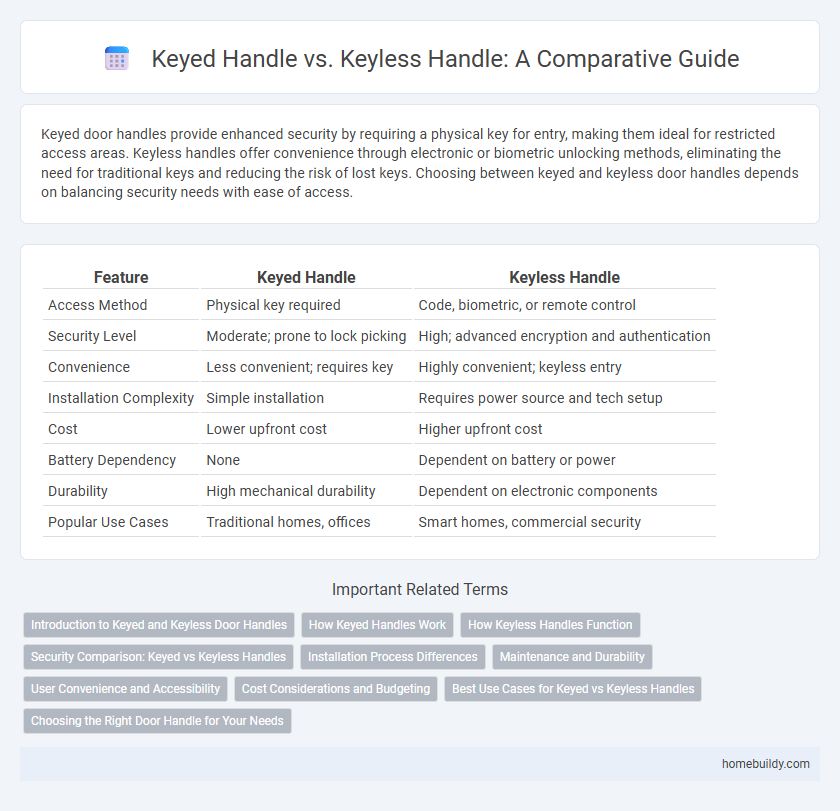Keyed door handles provide enhanced security by requiring a physical key for entry, making them ideal for restricted access areas. Keyless handles offer convenience through electronic or biometric unlocking methods, eliminating the need for traditional keys and reducing the risk of lost keys. Choosing between keyed and keyless door handles depends on balancing security needs with ease of access.
Table of Comparison
| Feature | Keyed Handle | Keyless Handle |
|---|---|---|
| Access Method | Physical key required | Code, biometric, or remote control |
| Security Level | Moderate; prone to lock picking | High; advanced encryption and authentication |
| Convenience | Less convenient; requires key | Highly convenient; keyless entry |
| Installation Complexity | Simple installation | Requires power source and tech setup |
| Cost | Lower upfront cost | Higher upfront cost |
| Battery Dependency | None | Dependent on battery or power |
| Durability | High mechanical durability | Dependent on electronic components |
| Popular Use Cases | Traditional homes, offices | Smart homes, commercial security |
Introduction to Keyed and Keyless Door Handles
Keyed door handles rely on a traditional lock-and-key mechanism, providing physical security by requiring a specific key for access. Keyless door handles use electronic or mechanical codes, biometric sensors, or keycards to grant entry, enhancing convenience and reducing the risk of lost keys. Both types offer varying levels of security and suitability depending on residential or commercial needs.
How Keyed Handles Work
Keyed door handles operate using a mechanical lock cylinder that requires a specific key to rotate and engage or disengage the locking mechanism inside the handle assembly. When the correct key is inserted and turned, pins within the cylinder align to allow the cylinder to rotate, which in turn retracts the latch bolt, granting access. This precise alignment of pin tumblers in the lock cylinder provides secure, reliable entry control compared to keyless handle systems.
How Keyless Handles Function
Keyless door handles operate using electronic or biometric systems that allow entry without a traditional key, enhancing security and convenience. Common mechanisms include keypad codes, RFID cards, fingerprint recognition, or smartphone app controls, which communicate with the locking mechanism to grant access. These systems often feature audit trails and remote management capabilities, making keyless handles ideal for modern residential and commercial applications.
Security Comparison: Keyed vs Keyless Handles
Keyed door handles provide physical security through traditional lock-and-key mechanisms, making unauthorized access dependent on key possession and lock integrity. Keyless handles utilize electronic or biometric authentication methods, offering enhanced protection against lock picking and key duplication while enabling remote access control and activity monitoring. Security effectiveness varies based on implementation quality, with keyed handles prone to physical lock tampering and keyless handles vulnerable to hacking or power failures.
Installation Process Differences
Keyed handles require drilling precise holes to accommodate the lock cylinder and typically involve aligning the lock mechanism with the door edge, demanding careful measurements for secure installation. Keyless handles offer easier installation, often requiring only basic tools to mount on the door surface without the need for extensive drilling or aligning internal components. The difference in installation complexity makes keyless handles more suitable for quick upgrades, while keyed handles provide enhanced security through a more intricate fitting process.
Maintenance and Durability
Keyed door handles generally require more maintenance due to their mechanical locking components, which can accumulate dirt and wear over time, potentially leading to jamming or key breakage. Keyless door handles, often featuring electronic or touch-based mechanisms, offer enhanced durability with fewer moving parts but depend on battery life and electronic reliability, which may necessitate occasional software updates or battery replacement. Choosing between keyed and keyless handles involves balancing the traditional robustness of mechanical locks against the convenience and technological maintenance of keyless systems.
User Convenience and Accessibility
Keyed handles provide enhanced security by requiring a physical key for access, which can be ideal for areas needing restricted entry. Keyless handles use electronic codes, biometrics, or touch sensors, offering faster and more convenient access without the need to carry keys. Keyless systems improve accessibility for users with mobility challenges or those who frequently enter and exit, reducing the risk of lost keys and enabling remote control options.
Cost Considerations and Budgeting
Keyed door handles generally have higher upfront costs due to the complexity of locking mechanisms and the need for matching keys, making them less budget-friendly for large-scale projects. Keyless handles, often equipped with electronic or biometric features, may require higher initial investments but reduce long-term expenses linked to key replacement and lock rekeying. Budget planning must weigh the trade-offs between installation costs, maintenance fees, and security requirements to select the most cost-effective door handle solution.
Best Use Cases for Keyed vs Keyless Handles
Keyed door handles provide enhanced security for residential and commercial properties where controlled access is critical, such as office buildings or storage rooms. Keyless door handles offer convenience and ease of use in high-traffic areas like hospitals or schools, allowing quick entry without the need for physical keys. Choosing between keyed and keyless handles depends on the balance of security requirements and operational efficiency specific to the environment.
Choosing the Right Door Handle for Your Needs
Keyed door handles provide enhanced security through traditional lock-and-key mechanisms, ideal for exterior doors requiring controlled access. Keyless handles offer convenience with features like electronic keypads or biometric entry, suitable for high-traffic areas or smart home integration. Selecting the right door handle depends on balancing security requirements, user convenience, and installation environment.
Keyed handle vs Keyless handle Infographic

 homebuildy.com
homebuildy.com